

How Does Uncle Tim's Building Blocks Work?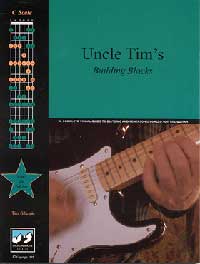
Simply! Here is the concept behind every page of UTBB.
On the fretboard of the guitar is a pattern of notes, once you learn it, you have immediate access to every scale in every part of the fretboard, for every key.
And it is easy to learn the pattern if you look at a picture of it, and music theory is what creates this pattern. This approach makes it super easy! Super easy!
There is nothing like it and nothing can make up for it. For $20, you can put this all to rest right now. Pick up a copy today.
eBooks are delivered instantly!
by Tim Gillespie
Everyone seems to like pentatonic keys. Anyone who has listened to rock and roll has heard pentatonic scales. They are the backbone of lead guitar for rock. They have been the single biggest driving force since the "twelve bar blues".
I have seen people who would ordinarily never play scales, jump at the chance to play pentatonic scales. Usually only a few fragments, and not the entire scale. Most of the time I see people learn, they pick a small pentatonic fragment and work out of that area when they feel the need to create a line.I think they are usually satisfied with inserting a little pentatonic flavor in their music.
You see pentatonic riffs everywhere. Keith Richards and Ron Woods of The Rolling
Stones heavily rely on pentatonic riffs for much of the secondary parts
they create. Eric Clapton uses pentatonic scales as effectively as anyone.
B.B. King works extensively out of "box" patterns and inserts
a mainstream  pentatonic
feeling into his music with them.
pentatonic
feeling into his music with them.
A "box" is just an area of the scale that forms a little box from which the musician carves a lead. Usually the box extends only a few frets and includes only a few notes. Boxes can live right on top of one another in the scale. To the right is a diagram of the pentatonic signature. Watch B.B. King next time you see him and notice he uses little boxes like these for lead line construction. Eventually he will start to incorporate some of the other (pink) notes and an extended run may develop. The yellow rectangles are examples of boxes.
Before we get to far, we need to get a few fact straight concerning pentatonic construction.
Pentatonic scales are constructed using some of the same notes as a diatonic scale. As you may know, western music is largely based on diatonic keys. The diatonic keys all have seven notes. They are referred to as the seven degrees of a diatonic scale. They also provide a handy reference for comparison as well as a baseline for construction.
Here are some examples of scales running down a string. The first example is the chromatic scale. This scale includes every possible note available. The second example is a C major diatonic scale. The third example is a C major pentatonic scale.
I have seen three different ways of constructing pentatonic scales. I have seen these scales constructed using the 1,2,3,5 and 6 degrees, the 1,2,3,6 and 7 degrees and the 1, 3, 4, 5 and 7 degrees. Expect to see these different signatures in this newsletter sometime in the fall.
The pentatonic construction that is most commonly referred to is the 1, 2, 3, 5 and 6 degrees. This is the pentatonic form we are going to discuss today. You can easily build the other forms with this information.
The pentatonic scale uses the 1, 2, 3, 5 and 6 notes of the diatonic scale.
This means the pentatonic scale discards the fourth and seventh notes of the diatonic scale. The F and B notes.
This also means the pentatonic scale is a subset of the diatonic scale. This is very important when soloing.
This information serves a couple of different purposes. First of all the pentatonic scale does not have to deal with the seventh note of the diatonic scale, the B note. The B note is right next to the C note. Since it is so close to the keynote of the scale (in this case C), it is very unstable. This can be awkward because it introduces a tension into a melody line that can be very hard to manage.
Anyone who has tried to improvise using a diatonic scale has probably encountered some difficulty managing the seventh degree of the scale. Certainly it can be managed successfully, but at first it can be problematic.
The other thing that happens by excluding the fourth and seventh notes is the spaces between notes get bigger. Notice the gaps between notes are the same or bigger then the diatonic scale they are a subset of. Now we have distances of one and one half steps between notes. Why is this important?
Think about this. One of the hardest things to manage with diatonic scale is they tend to sound like scales. This is because the notes are so close together. When you play them, there in not much difference from one note to the next. No so with pentatonic scales. The increased spacing of the notes makes them sound more distant from one another and more like a melody line. You can hear this if you practice the two different types of scales.
A byproduct of this increase in spacing is the fingerings necessary to play pentatonic scales. If you look at the spacing in the examples, you may notice there is not a lot of opportunity to play "three note per string pentatonic scales". The distance between notes is too far apart. In fact in this example, you can only play three note per string fragments between the first and fifth frets. Beyond the fifth fret, the notes are too far apart. So the mechanics are different and this too affects the sound of the scale.
Lets take a look at some standard spacing of scales and finger assignments.
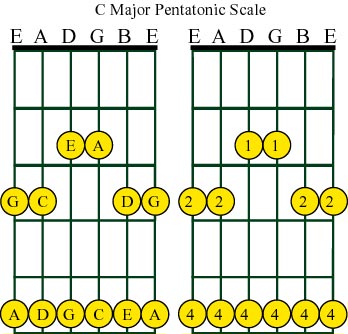
Here is a C major pentatonic and diatonic scale fragments between the first or second, and fifth frets.
Notice the pentatonic scale contains no notes on the first fret. These notes are omitted and this changes the finger assignments. To my ear, I can hear the difference in the finger strategy and this introduces some choppiness into the sound of a pentatonic scale.
The next example is a diatonic scale.
You can see the addition of notes on the first fret changes the finger assignments for this scale.
This scale will take quite a bit more practice to strengthen your fingers so they can hold down the large stretch on the E strings. The diatonic example will be much harder to play because of this extended stretch.
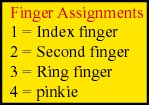 Here are the finger assignments for this exercise. In general these assignments
will work for most scales.
Here are the finger assignments for this exercise. In general these assignments
will work for most scales.
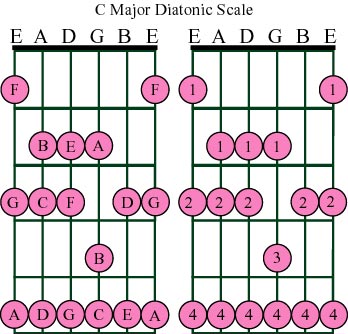
One of the reasons I suggest people play diatonic scales even if they choose to focus on pentatonic scales is because of this increase in difficulty. But also it is important to hear the differences between these two scales and match them up.
Diatonic scales contain all the notes in a standard key. It is important for your ear to hear all the notes as well as just the pentatonic notes. I cannot over emphasize this point. Hearing and knowing the diatonic sequence is extremely important. From this understanding comes the ability to put things in place inside a diatonic key.
You have to understand the key from a tonal perspective if you ever want to reach the higher levels of understanding. All the rules revolve around understanding the series of tones inside a key. I believe you must play scales to get your ear accustomed to understanding keys. That skill can only show up after you have practiced scales for a while. It will usually not show up quickly. It is a second level skill. It is built on the first level skill of being able to play a scale. It is one of the benefits of playing scales for years. A deep understanding of keys and scales will take time, but it is a very valuable piece of knowledge.
This frame of reference will really become important as you progress. Your sense of music will greatly expand and you will be grounded in diatonic keys. This is very important since most of the things we play are in diatonic keys!
The mechanics of playing diatonic scales should also be learned. Diatonic scales are fluid. They sound fluid when played by an accomplished guitarist. They really lend themselves to some Jazz, in part because of the fluid nature of the mechanics.
But What About Keys!
So far we have talked about pentatonic scales. What about keys. Is there such a thing as a pentatonic key?
Yes there is a pentatonic key. It is the framework that includes all the pentatonic notes for any key. But we usually do not construct chords using only pentatonic notes.
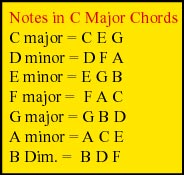 Here
is a graphic of the notes in the chords for the diatonic key of C major.
Here
is a graphic of the notes in the chords for the diatonic key of C major.
When you work out of the pentatonic key of C major, all the notes relate to the C note. But remember there is no F or B note in a C major pentatonic key. So technically any chord that uses either of these two notes is not in the key!
This presents some problems that are worth mentioning. Most of the time we work in pentatonic keys we are using single note melody lines. We usually use diatonic chords and overlay a pentatonic scale. Certainly you can avoid any note not in a pentatonic key when forming chords, but this usually is not done. However I think it is definitely worthy of study and experimentation. It could provide a chance to differentiate your music from the mainstream.
Any clashes of notes between pentatonic scales and diatonic chords is usually minor and can be easily dealt with. I suppose you could set up a song to magnify the conflict. That might be interesting!